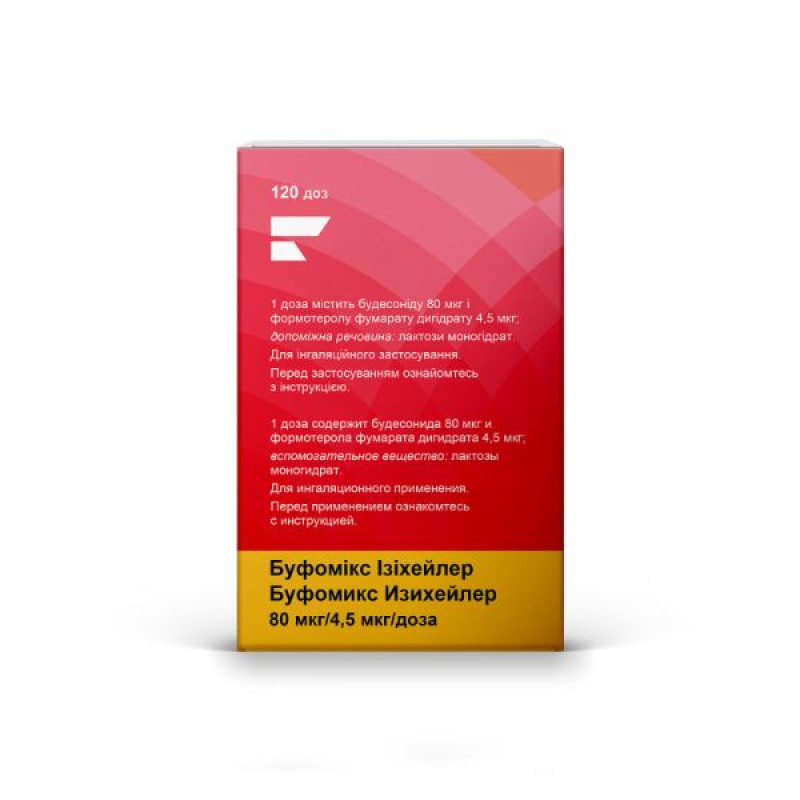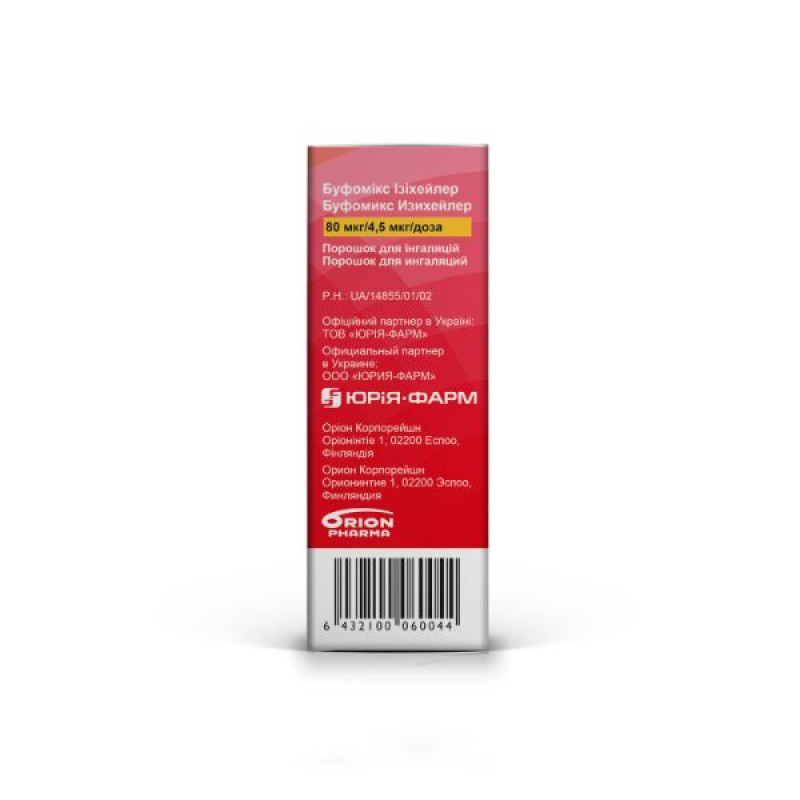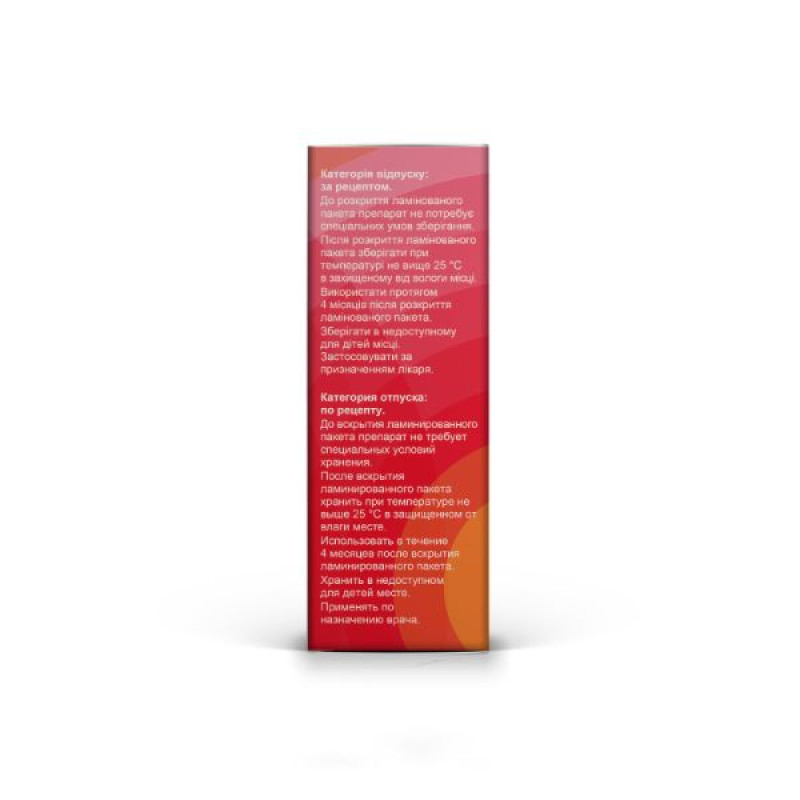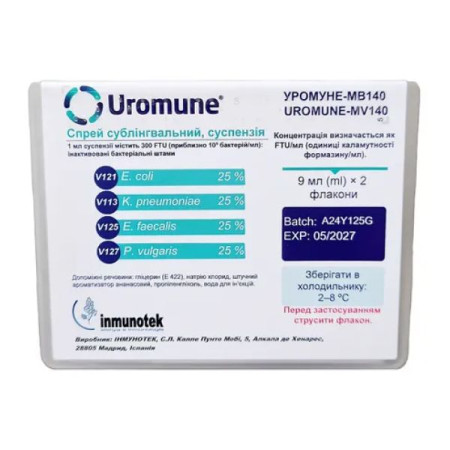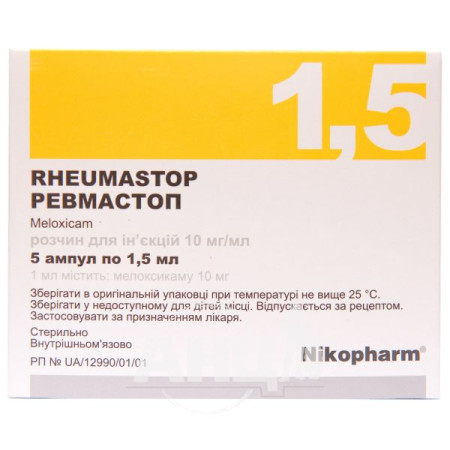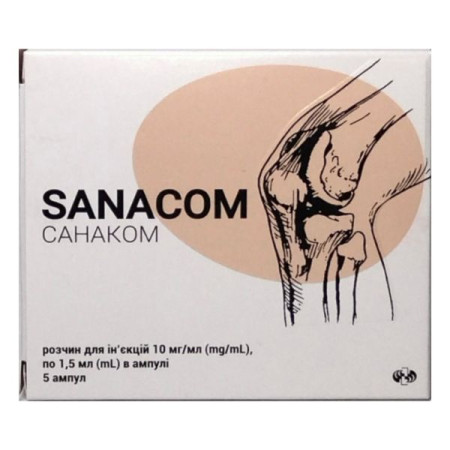Bufomix Easyhaler 80+4.5mcg/dose 120 doses No. 1
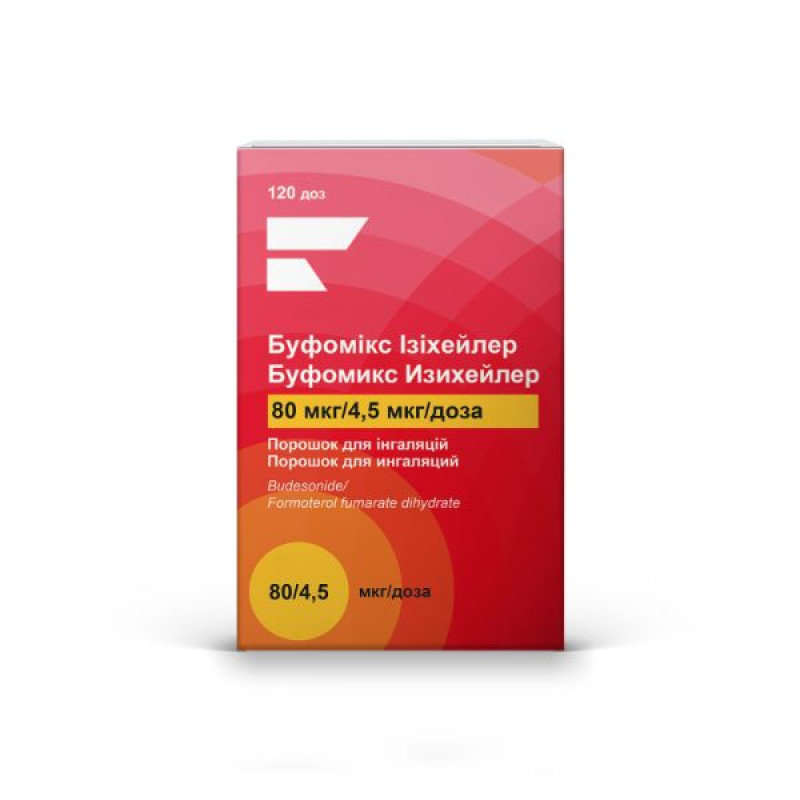
INSTRUCTION
for medical use of a medicinal product
BUFOMIKS EASYHALER
(BUFOMIX EASYHALER)
Composition:
active ingredients: budesonide, formoterol fumarate dihydrate;
1 dose contains budesonide 80 mcg and formoterol fumarate dihydrate 4.5 mcg;
excipient: lactose monohydrate.
Dosage form: Inhalation powder.
Main physicochemical properties: white or yellowish-white powder.
Pharmacotherapeutic group.
Drugs used in obstructive airway diseases. Adrenergic drugs in combination with corticosteroids or other drugs, except anticholinergic drugs. Formoterol and budesonide. ATX code R03A K07.
Pharmacological properties.
Pharmacodynamics.
Mechanisms of action and pharmacodynamic effects
The drug Bufomix Easyhaler contains formoterol and budesonide, which have different modes of action and exhibit additive effects in reducing exacerbations of bronchial asthma. The specific properties of budesonide and formoterol allow the combination to be used for maintenance therapy and symptom relief or for maintenance therapy of bronchial asthma.
Budesonide. Budesonide is a glucocorticosteroid that, when inhaled, exerts a dose-dependent anti-inflammatory effect in the airways, resulting in a reduction in the symptoms of bronchial asthma. Inhaled budesonide is characterized by less severe adverse effects than systemic corticosteroids. The exact mechanism of the anti-inflammatory effect of glucocorticosteroids is unknown.
Formoterol. Formoterol is a selective β2-adrenoceptor stimulator that, when inhaled, provides rapid and prolonged relaxation of bronchial smooth muscle in patients with reversible airway obstruction. The bronchodilator effect is dose-dependent and occurs within 1–3 minutes. The duration of the effect is at least 12 hours after taking a single dose.
Clinical efficacy and safety
Clinical efficacy of budesonide/formoterol maintenance therapy
Clinical studies in adult patients showed that adding formoterol to budesonide relieved asthma symptoms and improved lung function and reduced the frequency of exacerbations.
Two 12-week studies were conducted in paediatric populations in which 265 children aged 6-11 years were treated with maintenance doses of budesonide/formoterol (2 inhalations of 80 mcg/4.5 mcg/inhalation twice daily) and a short-acting β2-adrenergic agonist as needed. In both studies, improvements in lung function were observed and the treatment was well tolerated compared with the corresponding dose of budesonide alone.
Clinical efficacy of maintenance therapy and the use of budesonide/formoterol for symptom relief
The use of budesonide/formoterol for maintenance therapy and for symptom relief provided a statistically and clinically significant reduction in the frequency of severe asthma exacerbations compared with all other drugs.
In studies with patients seeking medical attention for acute asthma symptoms, budesonide/formoterol provided rapid and effective relief of bronchospasm symptoms similar to salbutamol and formoterol.
Comparable efficacy and safety in adolescents and adults were demonstrated in 6 double-blind studies, including 5 of the above studies and one additional study using a higher maintenance dose of two inhalations of 160/4.5 mcg twice daily. The estimates were based on data from a total of 14,385 patients with asthma, of whom 1,847 were adolescents. A limited number of adolescent patients used more than 8 inhalations of the drug (but infrequently) on at least one of the days of budesonide/formoterol maintenance therapy and symptom relief.
Pharmacokinetics.
Absorption
The fixed-dose combination of budesonide and formoterol and the respective mono-drugs have been shown to be bioequivalent with respect to the systemic exposure of budesonide and formoterol, respectively. However, a slight suppression of cortisol was observed after administration of the fixed-dose combination compared to the mono-drugs. This difference is not considered to have an impact on clinical efficacy.
There is no evidence of pharmacokinetic interactions between budesonide and formoterol.
Inhaled formoterol is rapidly absorbed, with Cmax achieved within 10 minutes after inhalation. In studies, the mean lung deposition of formoterol after inhalation using a dry powder inhaler ranged from 28% to 49% of the delivered dose. Systemic bioavailability was approximately 61% of the delivered dose.
Distribution and metabolism
Plasma protein binding is approximately 50% for formoterol and 90% for budesonide. The volume of distribution is approximately 4 l/kg for formoterol and 3 l/kg for budesonide. Formoterol is inactivated by conjugation reactions (active O-demethylated and deformylated metabolites are formed, but they are mainly observed as inactivated conjugates). Budesonide undergoes extensive (approximately 90%) first-pass biotransformation through the liver to metabolites with low glucocorticosteroid activity. The glucocorticosteroid activity of the main metabolites - 6-β-hydroxy-budesonide and 16-α-hydroxyprednisolone - is less than 1% of the glucocorticosteroid activity of budesonide. There is no evidence of any metabolic interactions or any substitution reactions between formoterol and budesonide.
Breeding
The majority of the formoterol dose is transformed by hepatic metabolism followed by renal excretion. After inhalation, 8–13% of the delivered formoterol dose is excreted in the urine as unchanged formoterol. Formoterol has a high systemic clearance (approximately 1.4 l/min) and a terminal half-life of an average of 17 hours.
Budesonide is eliminated by metabolism, mainly catalyzed by the enzyme CYP3A4. Budesonide metabolites are excreted in the urine in pure or conjugated form. Only very small amounts of unchanged budesonide are found in the urine. Budesonide has a high systemic clearance (approximately 1.2 l/min) and a plasma half-life of 4 hours after an intravenous dose.
The pharmacokinetics of budesonide or formoterol in patients with renal insufficiency are unknown. The exposure to budesonide and formoterol may be increased in patients with liver disease.
Linearity/nonlinearity
Systemic exposure for budesonide and formoterol is linearly correlated with the applied dose.
Clinical characteristics.
Indication.
The drug Bufomix Easyhaler (80 mcg/4.5 mcg) is indicated for use in adults, adolescents and children aged 6 years and older.
The drug is indicated for the regular treatment of bronchial asthma in the case of appropriate use of combination therapy (inhaled corticosteroid and long-acting β2-agonist):
– patients whose condition is not adequately controlled with inhaled corticosteroids and short-acting β2-agonists used as needed;
– patients whose condition is adequately controlled with inhaled corticosteroids and long-acting β2-agonists.
The drug Bufomix Easyhaler (80 mcg/4.5 mcg/dose) is not used in patients with severe bronchial asthma.
Contraindication.
Hypersensitivity to budesonide, formoterol or lactose, which contains small amounts of milk protein.
Interaction with other drugs and other types of interactions.
Pharmacokinetic interactions
Potent CYP3A4 inhibitors (e.g. ketoconazole, itraconazole, voriconazole, posaconazole, clarithromycin, telithromycin, nefazodone, cobicistat and HIV protease inhibitors) are likely to increase the plasma levels of budesonide and should therefore be avoided. If this is not possible, the interval between doses should be as long as possible (see section 4.4). Maintenance therapy is not recommended for patients taking potent CYP3A4 inhibitors.
The potent CYP3A4 inhibitor ketoconazole, 200 mg once daily, increased the plasma levels of concomitantly administered oral budesonide (single dose 3 mg) by an average of 6-fold. When ketoconazole was administered 12 hours after budesonide, the concentration increased by an average of only 3-fold, suggesting that separate administration may reduce the increase in budesonide plasma levels. Some data suggest that a significant increase in budesonide plasma levels (on average 4-fold) may occur when itraconazole 200 mg once daily is co-administered with inhaled budesonide (single dose 1000 mcg).
Concomitant use of cobicistat-containing medicinal products is expected to increase the risk of systemic adverse reactions. The combination should be avoided unless the benefit outweighs the increased risk of systemic corticosteroid adverse reactions. In such cases, patients should be monitored for systemic corticosteroid adverse reactions.
Pharmacodynamic interactions
Concomitant treatment with quinidine, disopyramide, procainamide, phenothiazines, antihistamines (terfenadine) and tricyclic antidepressants may prolong the QTc interval and increase the risk of ventricular arrhythmia.
In addition, levodopa, levothyroxine, oxytocin, and alcohol may impair cardiac tolerance to β2-sympathomimetics.
Concomitant use of monoamine oxidase inhibitors, including drugs with similar properties such as furazolidone and procarbazine, may cause hypertensive reactions.
The risk of developing arrhythmia increases during anesthesia with halogenated hydrocarbons.
Concomitant use of other β-adrenergic or anticholinergic drugs may enhance the bronchodilator effect.
Hypokalemia may increase the susceptibility to cardiac arrhythmias in patients treated with digitalis glycosides.
Hypokalemia may occur as a result of β2-agonist therapy and may be potentiated by concomitant use of xanthine derivatives, corticosteroids and diuretics (see section "Special warnings and precautions for use").
No interaction of budesonide and formoterol with any of the drugs used to treat bronchial asthma was observed.
Pediatric populations
Drug interaction studies have been conducted only in adults.
Application features.
It is recommended to gradually reduce the dose when discontinuing the drug and not to stop using it suddenly.
If patients feel that treatment is not effective or if they need to exceed the highest recommended dose of Bufomix Easyhaler, they should consult a doctor. Sudden and rapid deterioration in asthma control is potentially life-threatening and the patient should be evaluated immediately. In such cases, consideration should be given to increasing corticosteroid therapy, such as a course of oral corticosteroids, or antibiotic treatment if an infection is present.
The patient should be advised to always carry a rescue inhaler: either Bufomix Easyhaler (for patients with bronchial asthma who use Bufomix Easyhaler as maintenance therapy and relieve symptoms), or a separate fast-acting bronchodilator (for all patients who use Bufomix Easyhaler as maintenance therapy).
Patients should be reminded to take their prescribed maintenance dose of Bufomix Easyhaler even when they are not symptomatic. The prophylactic use of Bufomix Easyhaler, e.g. before exercise, has not been studied. Bufomix Easyhaler inhalers should only be used when asthma symptoms are present and are not intended for regular prophylactic use, e.g. before exercise. For this purpose, the use of a separate rapid-acting bronchodilator should be considered.
Once asthma symptoms are controlled, consideration should be given to gradually reducing the dose of Bufomix Easyhaler. It is important to review patients regularly when reducing the dose. The lowest effective dose of Bufomix Easyhaler should be used.
Do not start using this medicine during exacerbations, significant worsening or sudden complication of bronchial asthma.
The potential effect on bone mineral density should be considered, especially in patients receiving high doses for long periods and with concomitant risk factors for osteoporosis. Long-term studies of inhaled budesonide in children at average daily doses of 400 mcg (metered dose) or in adults at daily doses of 800 mcg (metered dose) have not shown any significant effect on bone mineral density. There is no information on the effect of high doses.
If there is reason to suspect deterioration of adrenal function due to previous systemic steroid therapy, caution should be exercised when transferring patients to Bufomix Easyhaler therapy.
The benefits of inhaled budesonide therapy usually minimize the need for oral steroids, but patients who are transferred from oral steroids are at risk of having reduced adrenal reserve for a long time. Recovery may be prolonged after discontinuation of oral steroid therapy, so patients who have previously used oral steroids and are transferred to inhaled budesonide may remain at risk for a long time due to impaired adrenal function. In such cases, regular monitoring of hypothalamic-pituitary-adrenal function is necessary.
Prolonged treatment with high doses of inhaled corticosteroids, particularly at doses higher than recommended, may result in clinically significant suppression of adrenal function. Therefore, additional systemic corticosteroid treatment should be considered during periods of stress, such as severe infections and elective surgery. Rapid reduction of steroid doses may precipitate acute adrenal insufficiency. Symptoms that may be seen with acute adrenal insufficiency include anorexia, abdominal pain, weight loss, fatigue, headache, nausea, vomiting, decreased level of consciousness, seizures, hypotension, and hypoglycemia.
Treatment with additional systemic steroids or inhaled budesonide should not be stopped abruptly.
When switching from oral medication to Bufomix Easyhaler, there is a general lower systemic steroid effect, which may lead to allergic or arthritic symptoms such as rhinitis, eczema, muscle and joint pain. In this case, specific treatment should be initiated. A general insufficient effect of glucocorticosteroids should be suspected if symptoms such as fatigue, headache, nausea and vomiting occur in isolated cases. In such cases, it may be necessary to temporarily increase the dose of oral glucocorticosteroids.
To reduce the risk of oropharyngeal candidiasis, patients should rinse their mouth thoroughly with water after inhalation of the maintenance dose. If oropharyngeal candidiasis occurs, patients should also rinse their mouth with water after use of the drug, if necessary.
Concomitant treatment with itraconazole, ritonavir or other potent CYP3A4 inhibitors should be avoided. If this is not possible, the interval between doses should be as long as possible. It is not recommended to use Bufomix Easyhaler simultaneously for maintenance and reliever therapy in patients taking potent CYP3A4 inhibitors.
Bufomix Easyhaler should be administered with caution to patients with thyrotoxicosis, pheochromocytoma, diabetes mellitus, untreated hypokalemia, hypertrophic obstructive cardiomyopathy, idiopathic subvalvular aortic stenosis, severe hypertension, aneurysm, or other severe cardiovascular disorders such as ischemic heart disease, tachyarrhythmia, and severe heart failure.
Caution should be exercised when treating patients with prolonged QTc interval. Formoterol itself may cause QTc interval prolongation.
In patients with active or inactive pulmonary tuberculosis, fungal and viral infections in the respiratory tract, the need and dose of inhaled corticosteroids should be reassessed.
Potentially life-threatening hypokalemia may develop during treatment with high doses of β2-adrenoceptor agonists. The hypokalemic effect of β2-adrenoceptor agonists may be enhanced by concomitant treatment with β2-adrenoceptor agonists and drugs that can cause hypokalemia or enhance the hypokalemic effect, such as xanthine derivatives, steroids and diuretics. Particular caution should be exercised in unstable bronchial asthma in the event of intermittent use of rescue bronchodilators, in acute severe bronchial asthma, since the associated risk is increased by hypoxia, as well as in other conditions where the risk of hypokalemia is increased. In these cases, it is recommended to monitor the level of potassium in the blood serum.
Use during pregnancy or breastfeeding.
Pregnancy: There are no clinical data on the effects of Bufomix Easyhaler or concomitant treatment with formoterol and budesonide on pregnancy. Animal embryo-fetal development studies have not shown any additive effect of the combination.
There are no adequate data from the use of formoterol in pregnant women. Formoterol has caused adverse effects in animal studies of reproductive effects at very high systemic exposure levels.
Data on approximately 2000 exposed pregnancies have not shown an increased teratogenic risk associated with inhaled budesonide. Animal studies have shown that glucocorticosteroids cause malformations. This is unlikely to occur in humans at recommended doses.
Animal studies have also found that excessive prenatal glucocorticoids increase the risk of intrauterine growth retardation, adult cardiovascular disease, irreversible changes in glucocorticoid receptor density, neurotransmitter turnover, and behavior at concentrations below the teratogenic dose range.
During pregnancy, Bufomix Easyhaler should be used only if the expected benefit outweighs the potential risk. The lowest effective dose of budesonide necessary to maintain adequate control of bronchial asthma should be used.
Breastfeeding. Budesonide is excreted in breast milk. However, at therapeutic doses, no effects on the breast-fed child are expected. It is not known whether formoterol is excreted in human milk. Small amounts of formoterol have been detected in animal breast milk. The use of Budesonide Easyhaler in breast-feeding women should only be considered if the expected benefit to the mother outweighs any possible risk to the foetus.
Fertility: There are no data on the potential effects of budesonide on fertility. In animal reproductive studies, formoterol showed a slightly reduced fertility in male rats at high systemic exposure.
The ability to influence the reaction speed when driving vehicles or other mechanisms.
The drug Bufomix Easyhaler has no or negligible influence on the ability to drive and use machines.
Method of administration and doses.
Dosage
Bronchial asthma
Bufomix Easyhaler is not prescribed for the initial treatment of bronchial asthma. The doses of the components of the drug are selected individually and adjusted according to the severity of the disease. This should be taken into account not only at the beginning of the use of combination drugs, but also when adjusting the maintenance dose. If the patient requires a combination of doses that differs from those available in the combination inhaler, appropriate doses of β2-adrenoceptor agonists and/or corticosteroids in separate inhalers should be prescribed.
The dose should be titrated to the lowest dose that effectively controls symptoms. Patients should be re-evaluated regularly by their prescriber to ensure that the dose of Bufomix Easyhaler remains optimal. Once long-term control of symptoms is achieved with the lowest recommended dose, symptoms should be controlled with an inhaled corticosteroid alone.
There are two options for using the Bufomix Easyhaler drug:
A. Maintenance therapy: Bufomix Easyhaler is used for regular maintenance therapy in combination with a separate rapid-acting bronchodilator used as a rescue medication.
B. Maintenance therapy and relief of symptoms: Bufomix Easyhaler is used for regular maintenance therapy and, if necessary, for relief of symptoms.
A. Supportive therapy
Patients should be advised to always carry a separate rapid-acting bronchodilator for use as a rescue medication.
Recommended doses:
Adults (aged 18 years and over): 1-2 inhalations twice daily. Some patients may require up to 4 inhalations twice daily.
Adolescents (12-17 years): 1-2 inhalations 2 times a day.
Children (age 6 and over): 2 inhalations 2 times a day.
Typically, after achieving control of the symptoms of the disease with the use of the drug twice a day, the dose is titrated to the lowest effective dose, including the use of the drug Bufomix Easyhaler 1 time a day, in cases where, in the opinion of the physician, the patient requires maintenance therapy with a long-acting bronchodilator in combination with an inhaled corticosteroid.
More frequent use of an additional rapid-acting bronchodilator indicates a worsening of the patient's condition and the need to review asthma treatment.
B. Supportive care and symptom relief
A daily maintenance dose of Bufomix Easyhaler is taken, and additional Bufomix Easyhaler is used as needed to relieve symptoms. Patients should be advised to always carry Bufomix Easyhaler for immediate use as a rescue medication.
The use of Bufomix Easyhaler for maintenance therapy and symptom relief should be considered in particular for patients:
• with insufficient control of bronchial asthma, who often need medications to relieve symptoms;
• with exacerbation of bronchial asthma in the past, which required medical intervention.
Patients who use Bufomix Easyhaler inhalations frequently and in large quantities as needed should be closely monitored for the development of dose-related adverse events.
Recommended doses:
Adults and adolescents (12 years of age and older): The recommended maintenance dose is 2 inhalations per day – 1 inhalation in the morning and evening or 2 inhalations in the morning or evening only. If necessary, in case of symptoms, 1 additional inhalation is used. If symptoms do not disappear after a few minutes, an additional inhalation should be taken. In any individual case, no more than 6 inhalations should be taken.
Usually, a total of no more than 8 inhalations are required per day, however, for a limited period, the total daily dose may be up to 12 inhalations. Patients who use more than 8 inhalations per day are strongly advised to consult a doctor. They should be re-examined and their maintenance therapy reviewed.
Children under 12 years of age: The drug is not recommended for use in children under 12 years of age as maintenance therapy and for symptom relief.
General information
Special patient groups
There are no special dosage requirements for elderly patients. There are no data on the use of Bufomix Easyhaler in patients with impaired renal or hepatic function. Since budesonide and formoterol are eliminated primarily by hepatic metabolism, increased exposure can be expected in patients with severe cirrhosis of the liver.
Method of application
For inhalation.
How to use Bufomix Easyhaler correctly
The inhaler is flow-controlled. This means that when the patient inhales air through the mouthpiece, the substance enters the airways along with the inhaled air.
It is important to draw the patient's attention to the following:
- Carefully read the instructions for medical use.
- Shake the device and activate it before each inhalation.
- Inhale through the mouthpiece actively and deeply enough to ensure the optimal dose of the substance enters the lungs.
- Do not exhale through the mouthpiece, as this will reduce the dose delivered. If this does happen, tap the inhaler on a table or in the palm of your hand to remove the powder from the mouthpiece, and then repeat the dosing procedure.
- Do not actuate the device more than once without inhaling the powder. If this does happen, the patient should tap the inhaler on a table or the palm of their hand to remove the powder from the mouthpiece, and then repeat the dosing procedure.
- Always put on the dust cap after using the inhaler to prevent accidental spraying of the powder from the device (which could lead to either an overdose or to inhaling an insufficient amount of the medicine the next time you use the inhaler).
- Rinse mouth with water after inhalation of the prescribed dose to minimize the risk of developing oral candidiasis. If oral candidiasis occurs, patients should rinse mouth with water after inhalation as needed.
- Clean the mouthpiece regularly with a dry cloth. Do not use water for cleaning as the powder is hygroscopic.
- Replace the Bufomix Easyhaler inhaler when the counter shows zero, even if some powder is still visible inside the device.
Children.
Bufomix Easyhaler is not recommended for use in children under 6 years of age. Use in children over 6 years of age as indicated in accordance with the doses specified in the section “Method of administration and dosage”.
Overdose.
Symptoms: Overdose with formoterol may be accompanied by symptoms usually observed with overdose of β2-adrenergic agonists: tremor, headache, tachycardia. In isolated cases, symptoms such as tachycardia, hyperglycemia, hypokalemia, prolonged QTc interval, arrhythmia, nausea and vomiting have been reported. Supportive and symptomatic treatment is indicated. A dose of 90 mcg taken over three hours by patients with acute bronchial obstruction was safe.
In acute overdose of budesonide, even after the use of excessive doses, clinical problems are not expected. In chronic use of excessive doses, glucocorticosteroid effects such as hypercorticism and suppression of the function of the adrenal cortex may occur.
If Bufomix Easyhaler therapy has to be discontinued due to formoterol overdose, appropriate inhaled corticosteroid therapy should be considered.
Adverse reactions.
Since the drug Bufomix Easyhaler contains both budesonide and formoterol, patients may experience adverse reactions characteristic of these two substances. No increase in the frequency of adverse reactions was observed after concomitant administration of these two substances. The most frequent drug-related adverse reactions correspond to the pharmacologically predicted adverse reactions of β2-agonist treatment. These are adverse reactions such as tremor and palpitations, which are usually minor and disappear after a few days.
Adverse reactions associated with budesonide or formoterol are listed below by system organ class and frequency. The frequency is defined using the following convention: very common (≥1/10), common (≥1/100 to <1/10), uncommon (≥1/1,000 to <1/100), rare (≥1/10,000 to <1/1,000), very rare (<1/10,000).
Infectious and parasitic diseases
Common: oropharyngeal candidiasis.
On the part of the immune system
Rare: immediate or delayed hypersensitivity reactions such as exanthema, urticaria, pruritus, dermatitis, angioedema and anaphylactic reaction.
From the endocrine system
Very rare: Cushing's syndrome, adrenal suppression, growth retardation, decreased bone mineral density.
Metabolism and nutrition
Rare: hypokalemia.
Very rare: hyperglycemia.
From the psyche
Uncommon: aggression, psychomotor hyperactivity, anxiety, sleep disturbances.
Very rare: depression, behavioral changes (predominantly in children).
From the nervous system
Common: headache, tremor.
Uncommon: dizziness.
Very rare: taste disturbance.
From the organs of vision
Uncommon: blurred vision.
Very rare: cataract and glaucoma.
Cardiovascular system
Common: rapid heartbeat.
Uncommon: tachycardia.
Rare: cardiac arrhythmias, e.g. atrial fibrillation, supraventricular tachycardia, extrasystole.
Very rare: angina pectoris, QTc prolongation, blood pressure fluctuations.
Respiratory, thoracic and mediastinal disorders
Common: moderate throat irritation, cough, dysphonia including hoarseness.
Rare: bronchospasm.
From the digestive system
Uncommon: nausea.
Skin and subcutaneous tissue disorders
Uncommon: bruising.
Musculoskeletal and connective tissue disorders
Uncommon: muscle cramps.
Oropharyngeal candidiasis is caused by drug retention. The patient should be advised to rinse the mouth with water after each dose to minimize the risk. Oropharyngeal candidiasis usually responds to topical antifungal treatment and does not require discontinuation of inhaled corticosteroids. If oropharyngeal candidiasis develops, the mouth should also be rinsed with water after administration, if necessary.
As with other inhalation therapy, paradoxical bronchospasm may occur rarely, affecting up to 1 in 10,000 patients. In this case, the patient experiences increased wheezing and shortness of breath immediately after taking a dose. Paradoxical bronchospasm responds to fast-acting inhaled bronchodilators and should be treated promptly. Bufomix Easyhaler should be discontinued immediately, the patient should be assessed and alternative therapy instituted if necessary.
Systemic effects of inhaled corticosteroids may occur, particularly when high doses are used over a long period of time. These effects are much more severe than those of inhaled corticosteroids.
There are no reviews for this product.
There are no reviews for this product, be the first to leave your review.
No questions about this product, be the first and ask your question.





